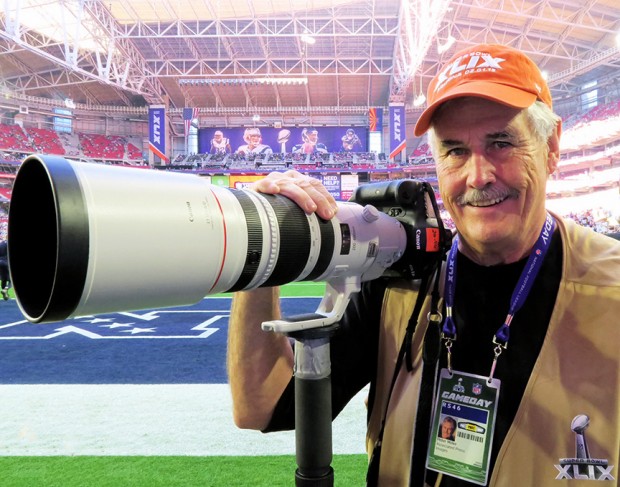
On the field pre-game
Last Sunday I shot my 39th Super Bowl. I know that sounds like a lot of Super Sundays, but it pales in comparison to photographers Mickie Palmer, Tony Tomsic, John Biever and Walter Iooss, -each of whom came into last Sunday's game having photographed all 48 of the previous Super Bowls. (For more of their stories check out Neil Leifer's cool new film Keepers of the Streak on ESPN.)
My first Super Bowl was 9 (I'll spare you the roman numerals). It was supposed to be played in the brand new Louisiana Superdome-the historic first indoor Super Bowl. Unfortunately the â˜dome was not completed in time and I found myself shooting in rusty old Tulane stadium with the game-time temperature hovering in the 40's and a steady rain coming down.
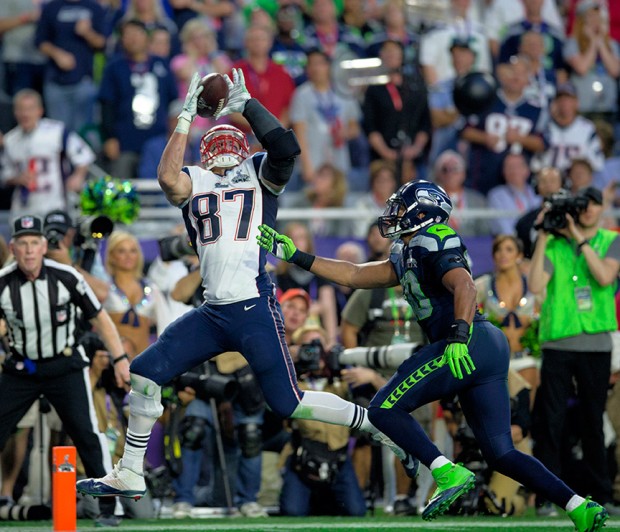
New England's Ron Gronkowski makes a touchdown catch in the second quarter - Canon EOS 1DX, Canon EF 400mm f/2.8 IS Series II lens, f/2.8 @ 1/1600, ISO 2000.
Leading up to Sunday, Phoenix had a pretty rainy week. Fortunately for all of us, the photographers, the players, and the fans, the sun came out on game day. In fact the weather was so good that they opened the roof to the University of Phoenix Stadium (aka "the big toaster"). While it lacks the grandeur of AT& T Stadium in Dallas, the U of P is a pretty good place to shoot with its roomy sidelines and good light.
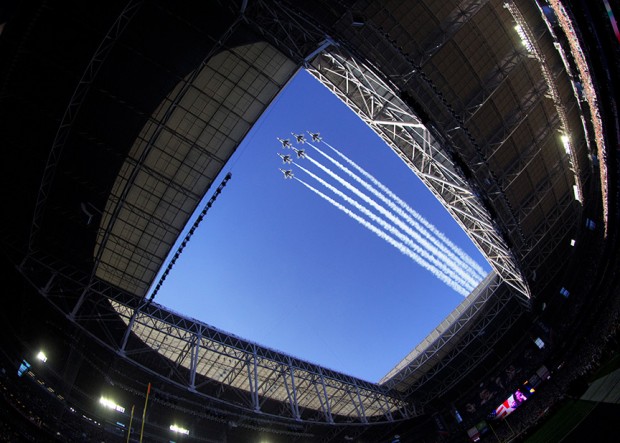
“The flyover" - Canon EOS 1DX, Canon EF 8-15mm f/4 lens @ 15mm, f/4 @ 1/8000, ISO 1600.
Most of my winning images have come from shooting on the sidelines, so let me take a moment to explain the setup here. Sideline space at any game is precious, but especially at the Super Bowl. There are several hundred credentialed field photographers and at least as many TV, video, and NFL Films personnel all sharing the same space on the field. Most of the crowding happened in the corners of the end zones. The end zone space was at a real premium due to the fact that there were at least 10 television cameras in permanent positions in either end zone. Crossing an end zone was a little like running an obstacle course requiring stepping up and over photographers, assistants and film runners, then back down to your knees for a few feet to duck under a camera, then up again, then down again. To avoid the gymnastics routine, I decided to shoot almost exclusively from the Patriots side of the field.
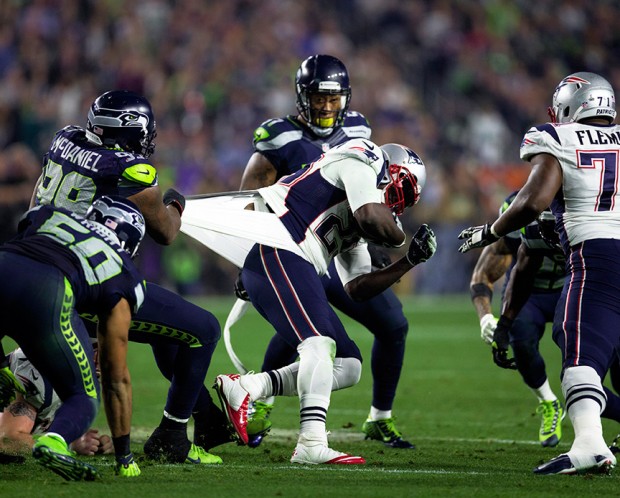
Seattle's defense gets a piece of New England running back LaGarrette Blount - Canon EOS 1DX, Canon EF 400mm f/2.8 IS Series II lens, f/2.8 @ 1/1600, ISO 2000.
Locations aside, my gear selection is just as important because there isn't a do-over opportunity to run back into your car to grab that extra lens or accessory. So what gear did I use for the game? My go-to sports action camera has been the Canon EOS 1DX since it was introduced in 2012. On Sunday I used three of them to capture the game. My backup was my new favorite lightweight action camera, the Canon 7D Mark II. With a burst speed of 10 fps and incredibly fast auto-focus, the 7D2 makes a great companion to the 1DX.
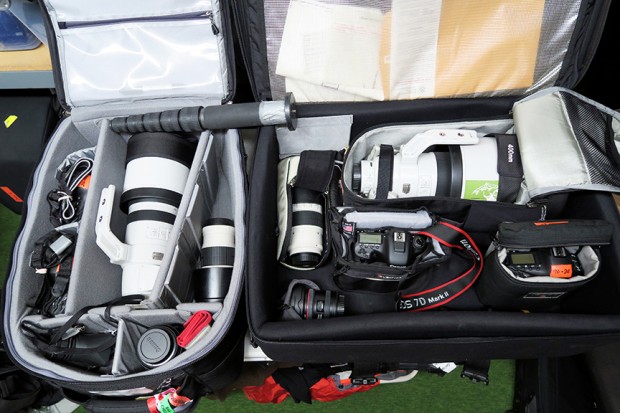
My gear packed for the game
My long lens for the game was the EF 400 f/2.8 IS Series II exclusively. I went with this lens over my beloved EF 200-400 f/4 because if you add the Canon EF 1.4x Extender to a 400mm, it will give you a 560mm f/4, while the 200-400mm built in extender will drop it to f/5.6. The extra focal length is a big help with shooting at a crowded game like Sunday's. And although the light at the beginning of the game was sufficient to shoot f/5.6 at ISO 4000, it soon started dropping as the sky darkened.
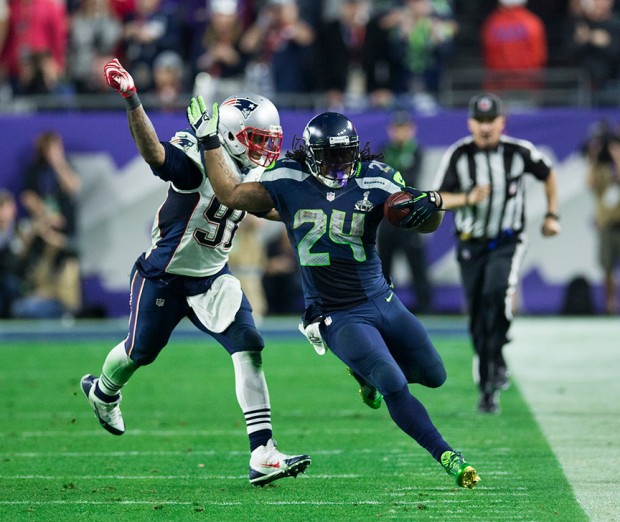
Seattle's Marshawn Lynch runs after a catch in the fourth quarter - Canon EOS 1DX, Canon EF 400mm f/2.8 IS Series II lens, f/2.8 @ 1/1250, ISO 2000.
My exposure for most of the game was set to 1/1600 @ f/2.8 at 2000 ISO. When I shot at f/4 with my 70-200 zoom or with the extender on the 400, I cranked the ISO up to 4000. My physical set-up was the 400mm with the EOS 1DX set on a monopod, and one 1DX with a 24-70 on a short strap and the other 1DX with a 70-200 on a longer strap below it both around my neck. This is my favorite set-up for accessibility, although it does eventually take a toll on my neck.
Leading up to the Super Bowl this year, a number of my Twitter followers asked me how would I approach shooting the "biggest game of the year"? My answer: "Hopefully not any differently than I did any other game I shot this season." After my first Super Bowl I had a conversation with Dave Boss of NFL properties. Dave was a friend and mentor, a multi-talented artistic genius who founded NFL Creative Services. I told him how disappointed I was with my photos from the game, how I thought they should be somehow better. Dave made the point that the Super Bowl is, at the end of the day, a football game. The teams will play 60 minutes, or more if you are lucky. Passes are thrown, tackles are made, touchdowns are scored, balls are fumbled and field goals are made, or missed. Players will play with intensity and brilliance and sometimes they make mistakes that will stay with them a lifetime.
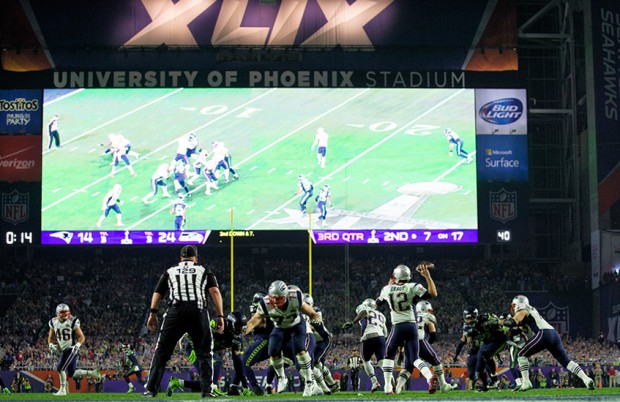
New England's Tom Brady drops back to pass - Canon EOS 1DX, Canon EF 70-200mm f/4 IS lens, f/4 @ 1/1250, ISO 2000. The low angle was achieved by shooting from ground level using the Canon Angle finder C.
When I am not shooting from the sidelines, I teach workshops around the country to aspiring sports photographers or photographers looking to build on their craft and I always tell them the same bit of advice Dave gave to me: "As a photographer, your job is to cover the action that takes place on the field and not to be distracted by the hype, the hoopla, and the shear tsunami of bullsh*t that goes on around this game."
Sunday's game was a fantastic NFL football game. From the comfort of your home, there is a lot that you don't see of what photographers have to go through on the field. Here's what you missed:
– A two-hour bus journey to the game including mysterious waiting around and being transferred to other buses.
– A thorough security check. I get the importance of heighted security during an event like this, but it took some folks up to an hour to go through and lay their gear out on the ground to be sniffed by bomb dogs (I'm glad I left my doggie bones at home!).
– The chaos during the Katy Perry half-time show. Photographers who were trying to shoot Ms. Perry were moved from spot to spot and moved again and again until it was nearly impossible to shoot anything except the very end when she flew above the field.
– The double chaos during the last few moments of the game. In an effort to keep photographers off the field at the end of the game, the NFL places hundreds of security personnel shoulder-to-shoulder on the sidelines. Did you see at the end of the game where some photographers almost reach the line of scrimmage with 18 seconds left on the clock? Yeah those photographers probably ended up missing the most important shots of the game. After so many years, you'd think they'd figure it out.
– The worst trophy presentation (visually speaking) since they started doing them on the field (as opposed to the locker room). The presentation was aimed away from everyone except for a stand of television cameras and the background of LED advertising boards when usually it's the darkened stands with showers of confetti.
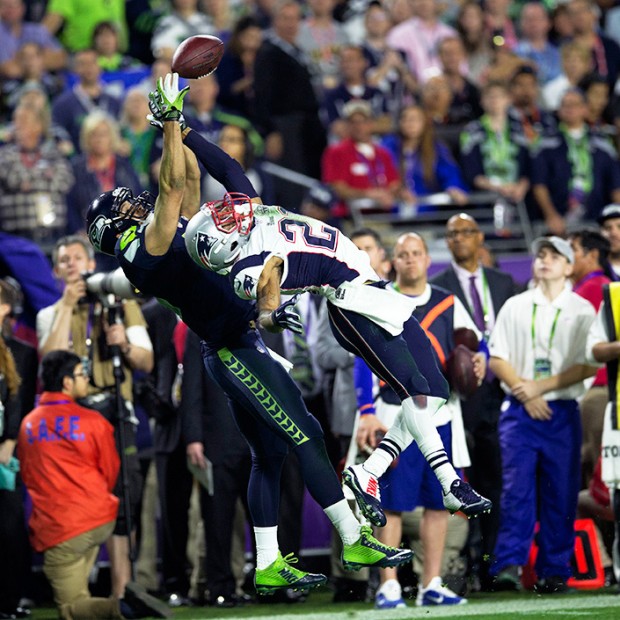
New England DB Brandon Browner tires unsuccessfully to break up a Russell Wilson pass to Seahawk WR Jermaine Kearse - Canon EOS 1DX, Canon EF 400mm f/2.8 IS Series II lens, f/2.8 @ 1/1600, ISO 2000.
The chaos, and waiting aside, being on the sidelines is definitely worth it. This past Sunday's game had the Super Bowl's usual series of difficulties and distractions, but unlike so many of these games, it was, I think, one of the most exciting Super Bowls ever. It was a great 39th for me and it left me looking forward to next year's game in San Francisco.
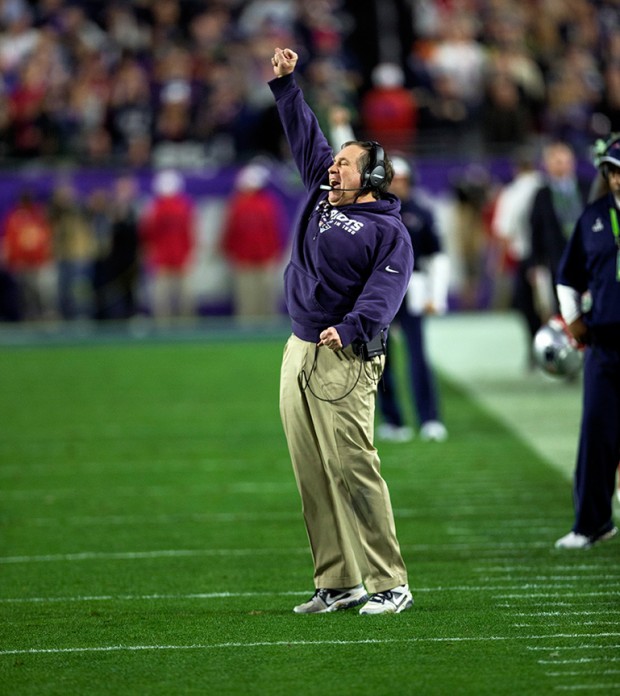
The rarest moment of NFL action-a happy Bill Bellichick - Canon EOS 1DX, Canon EF 400mm f/2.8 IS Series II lens, f/2.8 @ 1/1250, ISO 2000.
You can see more of Peter’s work at PeterReadMiller.com, pick up his book On Sports Photography, and follow him on Twitter and Facebook for updates on his latest shoots and workshops.



Good article much love from Miami FL
why did you use a 70-200 f4 instead of the 2.8?
I’m gonna guess because it weighs less than the 2.8.
As Bill mentioned, it’s a weight issue. The f4.0 version of the 70-200 weighs half as much as the f2.8 version and is a pretty amazing lens wide open. Shooting how Peter mentioned with 2 1Dx’s around one’s neck with both a 24-70 2.8 and 70-200 f2.8 on them would be almost impossible for a full football game.
great shots, but that’s Butler on the Kearse catch not Browner, and we all know the epic INT that happens right after that Kearse catch by that same DB Butler! Go Pats!
Great images Peter! I have a question. On the second to last image, where Kearse ends up making the circus catch on his back, did you follow him to the ground and continue shooting? I’m sure you were tracking the players and ready to catch the image you made, but what about the aftermath? In my limited experience of shooting sports I found it hard to “follow through” with the action after you “thought” you had the shot nailed.
a corrx to the first caption: it’s Rob not Ron Gronkowski. I love good sports photography!
Any feedback / observations about the change in lighting in that stadium to LED lights ?
Good post btw.
Big respect! I’d love to see some shots and read some stories from the first games of the old times from such a ‘veteran’, when it was all done with film, manual focus and no crazy iso.
Congrat’s on #39, hope you have an update next year on #40!
Thanks for sharing your process.
Great information!